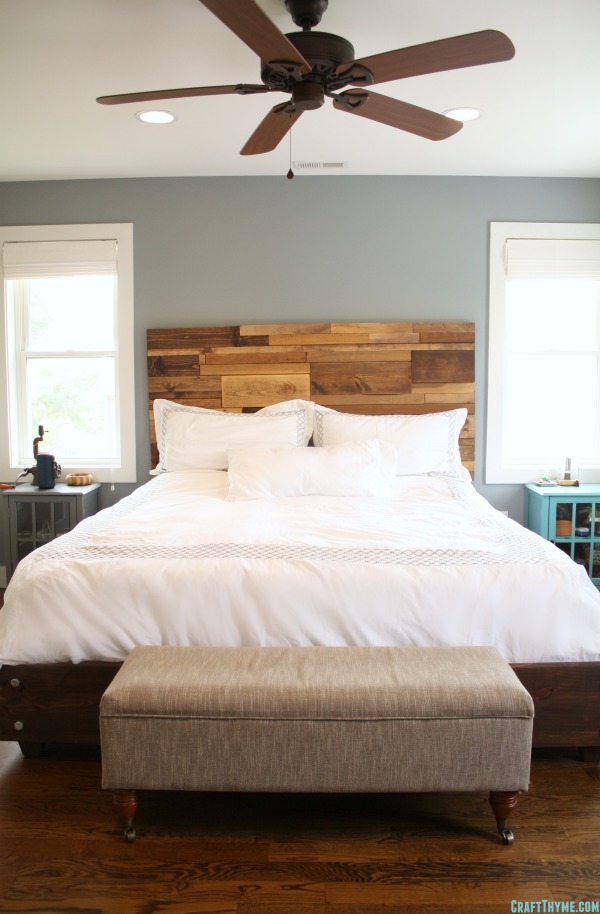
I don’t know about you, but I’ve got a lot of wood. After building string art projects for the boys, crafting a few salvaged wood coffee and side tables (post forthcoming), building a chicken coop capable of passing human occupancy code (also a future post), and saving some beautiful walnut hardwood flooring from the construction dumpster next door, I had managed filled both our porch and crawlspace with stacks of “one day I’ll do something with this” wood. So while Brianna was in Seattle for her cousin’s college graduation, I figured it was finally time to get crafty!
The one room in our home where we have done absolutely NOTHING to make the space more “us” is our bedroom. Shocker, right? We spend a third of our day (and on a good day more than that) in this space, and it’s easily the blankest canvas outside of the stairwell – and even that has an industrial pop to it! (Yes, another future Adam post) For about a month following our move into the house, every time B and I would head to Target we’d find new bedding on clearance, and with Cartwheel, we’d walk away with a King set for around $25-$40. So great, we’re got some funky lamps we made with Edison-style bulbs and a few sets of bedding. Not a single other piece of hardware or decoration…. For two people that run a craft blog, this is a sacrilege!

Brianna and I had built our own bedframe prior to moving in, and it’s got a very rustic/industrial feel to it. Big, stained, thick lumber with 3/4″ hex bolts to hold it together. I wanted to stick with this look and feel and take it vertical. Project decision: Headboard.

From building the chicken coop (or “palace” as many of our neighbors have proclaimed), I had a few scraps of 3/4″ sanded pine plywood left over. Each piece of scrap was 48″ tall, but the widths of the pieces varied: 10.25″, 12.5″, 27.5″ and 36″. Luck should have it that 12.5 + 26.5 + 36 = 76; a perfect backplane for a kind headboard! I trimmed each piece to a height of 36″, laid them side by side, and began to lay out the pieces of scrap and salvaged wood in a perfectly haphazard mosaic arrangement.
Did I mention that a lot of the left over wood was painted, marred, chipped, slightly twisted, or naturally weathered? I incorporated failed projects that were painted orange, blue and white, lumber I’d left out in the rain, thin lumber used as makeshift paint stands, and a few pieces of furniture grade wood purchased for endeavors never embarked upon as well. Each piece of lumber was dimensionally 1″ (meaning an actual thickness of 3/4″). I tried to mix textures and colors fairly evenly throughout, made cuts when necessary to fit the salvaged wood onto the backplane, and in the end came up with the following general layout:

Next step? Staining!
Using left over stains from the (to be written) Edison bulb light fixture project, I chose pieces out of the pictured layout to stain different colors. I used Rust-Oleum Dark Walnut and Minwax Early American stains and allowed for varying set times before wiping off the stain with a cotton rag. When doing this, I wanted to make sure each piece of white wood got a good dose of color. The end result?

Now remember that at this point nothing has been attached to the backplane. I’d gone back and forth between wood glue, liquid nails, and 1-1/4″ finishing nails to accomplish this goal. In the end, because I was terribly impatient, I opted for the physical nail option. So I pulled out my good old Porter Cable pancake air compressor and my 18-gauge brad nailer nail gun and got to work. The nice thing about finishing nails is that they have a relatively strong hold and leave virtually no visible holes with this type of wood finish. After 5 minutes of nailing, the headboard was complete. All that was left to do was move this baby upstairs and mount it!
Getting this thing upstairs, especially by myself, was quite the task. The finished product weighed in around 75lbs, and while that weight is more than manageable, at 76″ x 36″ it is terribly awkward to carry up a turning flight of stairs without hitting the first floor ceiling. Nevertheless, I finally made it to our bedroom.
Knowing how much the headboard weighed, I now had to find a means to mount this baby to the wall. After a bit of searching through different options, I chose to use an 18″ French Cleat* capable of supporting up to 200lbs. Why the extra support? With four boys, I envisioned at least one of them with a misfiring neuron doing pull ups on the headboard while playing on the bed. The french cleat cost us just under $9 from Lowe’s and was the only out-of-pocket expense for the whole project.
I followed the provided installation instructions for mounting the wall portion of the bracket while making sure to hit at least one stud in the process. In some cases you should be able to hit two studs over a span of 18″. The particular cleat we used came with a built in level thereby making installation a breeze! I then mounted the second part of the cleat to the headboard in the same horizontal position. Once everything was securely fastened, it was time to hang this sucker on the wall.

